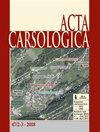卡拉和白色沙漠(埃及西部沙漠)的喀斯特岩石浮雕
IF 1.1
4区 地球科学
Q4 GEOSCIENCES, MULTIDISCIPLINARY
引用次数: 0
摘要
岩溶岩石地貌清楚地揭示了岩溶地表和岩溶洞穴的形成和发展过程。最古老的痕迹是古老岩溶洞穴的岩石特征,这些洞穴是在与现在完全不同的气候条件下,即在更新世形成的,而且干燥的时间更长。如今,风是塑造地表岩石的主要因素,特别是在法拉夫拉附近的白色沙漠岩溶中,我们可以看到一系列风成岩的发展过程,这有助于我们对它们进行合理的分类和分级。然而,在卡拉绿洲附近的瓦迪斯,一种独特的岩石地貌正在形成,在这些岩石地貌中,水流的痕迹和砂质沉积物下岩石的溶解是最主要的。虽然降雨量较小,但短时间内的强降雨足以塑造出抵抗力较弱的岩石。岩壁上主要的岩石特征是由溶解和风化侵蚀共同形成的。岩石表面与水接触的部分会形成岩壳。而裸露的表面则是由风力侵蚀而成。在岩壳剥落的地方,风会雕刻出杯子。本文章由计算机程序翻译,如有差异,请以英文原文为准。
Karst Rock Relief of Qara and White Desert (Western Desert of Egypt)
The karst rock relief clearly reveals the ways in which the karst surface and caves have been shaped and how they have developed. The oldest traces are the rock features of old karst caves, which were formed under climate conditions entirely different from the current ones, i.e., in the Pleistocene, and which have been dry for a longer period of time. Today, the wind is the prevailing factor in shaping the rock on the surface and in the karst of the White Desert near Farafra in particular, where we can witness the development of an entire range of wind rock features which helps us sort and classify them logically. However, in the wadis near the Qara Oasis a unique rock relief is forming, in which traces of water flow and dissolution of the rock under the sandy deposits are utterly predominant. The rainfall volume is low, however, the heavy rainfall events lasting short periods of time are enough to shape the less resistant rock. The rock features dominating the walls are co-shaped by dissolution and aeolian erosion. Crust forms on those parts of the rock surface that come in contact with water. The bare surfaces, on the other hand, are carved out by the wind. In the places where the crust has flaked off, the wind carves out cups.
求助全文
通过发布文献求助,成功后即可免费获取论文全文。
去求助
来源期刊

Acta Carsologica
地学-地球科学综合
CiteScore
1.50
自引率
14.30%
发文量
0
审稿时长
>12 weeks
期刊介绍:
Karst areas occupy 10-20 % of ice-free land. Dissolution of rock by natural waters has given rise to specific landscape and underground. Karst surface features and caves have attracted man''s curiosity since the dawn of humanity and have been a focus to scientific studies since more than half of millennia.
Acta Carsologica publishes original research papers and reviews, letters, essays and reports covering topics related to specific of karst areas. These comprise, but are not limited to karst geology, hydrology, and geomorphology, speleology, hydrogeology, biospeleology and history of karst science.
 求助内容:
求助内容: 应助结果提醒方式:
应助结果提醒方式:


